Thai Coconut Jelly Dessert You’ll Make Again and Again
Thai Coconut Jelly Dessert is a creamy, jiggly tropical treat that captures everything people love about Thai sweets: refreshing ingredients, subtle sweetness, and beautiful presentation. It’s a staple during Thailand’s warm seasons, and today, it’s capturing hearts worldwide. Whether you’re hosting a brunch, planning a summer dessert table, or simply craving a healthy sweet snack, this jelly checks every box.
This recipe, like many on Just Thai Recipes, is rooted in a love for Thai flavors. Our story began with Lina a passionate home cook raised on bold Thai spices and comfort dishes. She started the blog to share her culinary traditions with the world, and since then, every dish we publish carries the same goal: bring joy through flavor. Thai Coconut Jelly Dessert is no exception. This simple, elegant dessert was one of the first recipes Lina made with her grandmother. Now it’s a reader favorite light, tropical, and irresistibly creamy.
In this article, we’ll walk you through how to make Thai Coconut Jelly Dessert from scratch, explain why it’s such a beloved sweet in Thai culture, and show you how to customize it using fruits or keto-friendly swaps. Whether you’ve heard it called Wun Maprao, coconut jelly, or even compared it to Vietnamese jelly, we’ll answer all your questions, step by step.
If you’re looking for more Thai treats, don’t miss our Thai Coconut Custard recipe another melt-in-your-mouth dessert that blends creamy textures with bold coconut flavor.
Table of Contents
Table of Contents
Understanding Thai Coconut Jelly Dessert
What is Thai Coconut Jelly Dessert?
Thai Coconut Jelly Dessert locally known as Wun Maprao is a cool, creamy dessert made from coconut milk, coconut water, and gelatin. It’s traditionally chilled in small cups or jars and topped with slices of tropical fruit like mango or lychee. Its soft, jiggly texture and delicate sweetness make it ideal for hot weather and festive gatherings.
You’ll often find this dessert sold by Thai street vendors, especially near beaches and night markets. It’s also made at home using simple, wholesome ingredients, which makes it perfect for new cooks exploring Asian desserts.
This sweet treat is part of the broader category of Thai jelly desserts, which also includes Thai pandan jelly and red rubies. But Wun Maprao stands out because it combines the richness of coconut milk with the freshness of coconut water, offering the best of both worlds in one jar.
The Meaning Behind the Name
So, what is the name of Thai Coconut Jelly? As mentioned earlier, in Thai it’s called Wun Maprao:
- Wun means jelly.
- Maprao means coconut.
This simple name reflects the dish’s main ingredient and texture. It’s straightforward, just like the recipe itself uncomplicated but bursting with flavor.
Thai Coconut Jelly vs. Other Names
You might be wondering: What is coconut jelly called in other cultures? It depends on the region. In general:
- In Japan, a similar dessert may be called coconut kanten when made with agar.
- In Vietnam, it’s known as thạch dừa, often firmer and served in coconut shells.
- In the Philippines, a variation exists called buko pandan—a green, fragrant jelly with similar ingredients.
- Some fans in the U.S. even refer to it as Melo Melo (named after a popular coconut jelly brand), though that version may include whipped coconut cream and vanilla.
If you’ve tried those versions, get ready—Thai Coconut Jelly Dessert is softer, creamier, and typically topped with tropical fruits for a clean, refreshing finish.
When to Serve Thai Coconut Jelly
This dessert is incredibly versatile. Serve it:
- As a light finish to a spicy Thai meal
- At brunch or baby showers
- During summer barbecues
- Or simply as a guilt-free midnight snack
Want to go savory first? Check out our Thai Coconut Curry Dumpling Soup for a comforting dish to pair before dessert.
Thai Coconut Jelly Dessert isn’t just delicious—it’s an experience of texture, tradition, and tropical flavors in every bite. Now that you understand its charm, let’s explore what goes into it next.
Print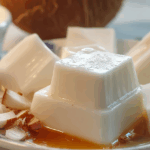
Thai Coconut Jelly Dessert
- Prep Time: 10 minutes
- Cook Time: 5 minutes
- Total Time: 4 hours 15 minutes (includes chilling)
- Yield: 6 servings 1x
- Category: Dessert
- Method: No-Bake
- Cuisine: Asian-Inspired
- Diet: Low Lactose
Description
This Coconut Milk Jelly is a light, creamy, and naturally sweet dessert made with full-fat coconut milk, honey (or allulose for a keto option), and fresh fruit. It’s perfect for a refreshing, no-bake treat.
Ingredients
- 1 cup coconut water, divided
- 2½ teaspoons unflavored gelatin powder
- 2½ cups full-fat coconut milk
- ¼ cup honey (or ⅓ cup liquid allulose for keto)
- ½ teaspoon vanilla extract
- 1½ cups sliced fresh fruit (optional, for topping)
Instructions
- Pour ¼ cup of the coconut water into a small bowl. Add the gelatin and whisk until well-incorporated. Set aside to let the gelatin bloom and rehydrate.
- In a small saucepan, combine the remaining coconut water, coconut milk, and honey. Heat over medium, stirring frequently until the honey dissolves and the mixture is hot but not boiling.
- Remove from heat and whisk in the hydrated gelatin and vanilla extract, ensuring there are no lumps.
- Strain the mixture through a fine mesh sieve into a liquid measuring cup to remove any lumps. Skim off bubbles if needed.
- Evenly divide the mixture into six 6-ounce glass jars.
- Refrigerate the jars uncovered for 1 hour. Then cover and chill until fully set, about 4 hours.
- Top with sliced fresh fruit if desired before serving.
- Store in sealed containers in the fridge for up to 3 days.
Notes
- Use full-fat coconut milk for best texture and flavor.
- Honey provides a light sweetness, but allulose makes this keto-friendly.
- Make sure gelatin is fully bloomed before adding to hot liquid to prevent clumping.
- Fresh fruit adds color and flavor but is optional.
Nutrition
- Serving Size: 1 jar (approx. 6 oz)
- Calories: 190
- Sugar: 7g
- Sodium: 20mg
- Fat: 17g
- Saturated Fat: 15g
- Unsaturated Fat: 2g
- Trans Fat: 0g
- Carbohydrates: 10g
- Fiber: 1g
- Protein: 2g
- Cholesterol: 0mg
Keywords: Coconut Milk Jelly, No Bake Dessert, Keto Coconut Jelly, Dairy Free Pudding, Coconut Dessert
Thai Coconut Jelly Dessert Ingredients
Simple Ingredients with Authentic Thai Roots
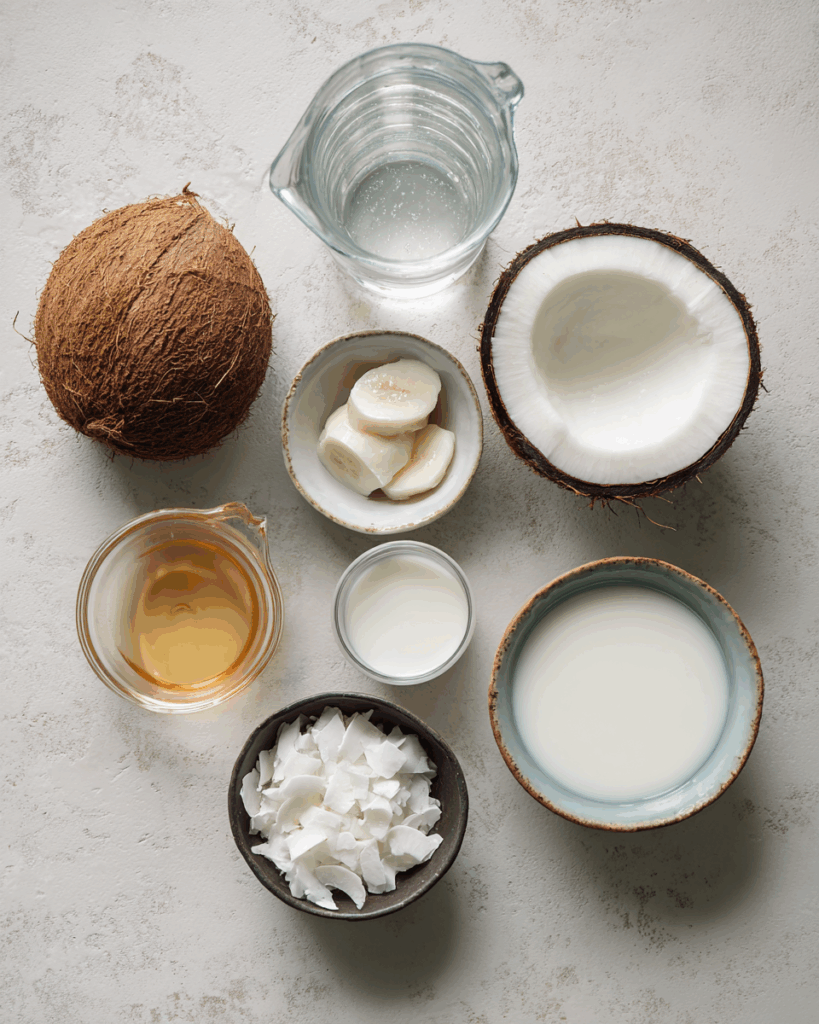
The beauty of Thai Coconut Jelly Dessert lies in its minimal, clean ingredients—each one contributing to that rich-yet-light tropical profile. It’s not only easy to prepare, but every element used in this dessert serves a purpose, from texture to flavor to setting consistency.
Here’s what you’ll need to create the classic Thai version at home:
| Ingredient | Purpose | Notes |
|---|---|---|
| Coconut Milk (2½ cups) | Adds creaminess and body | Use full-fat for best texture (Aroy-D or Native Forest Simple Organic) |
| Coconut Water (1 cup, divided) | Provides subtle sweetness and lightness | Taste Nirvana in glass bottle preferred |
| Unflavored Gelatin (2½ tsp) | Sets the jelly into a soft, creamy texture | Bloom in cold coconut water first |
| Honey (¼ cup) | Sweetens the dessert naturally | Use light-colored honey or allulose for keto |
| Vanilla Extract (½ tsp) | Adds aroma and depth of flavor | Optional but recommended |
| Fresh Fruit (1½ cups, optional) | Adds vibrant color and nutrition | Mango, lychee, kiwi, or berries work best |
Looking for a plant-based alternative? Swap out gelatin with agar-agar powder for a vegan-friendly twist. You’ll find a wonderful step-by-step on using coconut agar jelly in this Hot Thai Kitchen coconut agar-agar jelly guide, which shows how to adjust texture and flavor when using agar.
Understanding the Role of Each Ingredient
Let’s take a deeper look into these core ingredients:
Coconut Milk
Full-fat coconut milk gives this dessert its signature richness. Unlike skim or low-fat options, full-fat milk helps the dessert hold its shape while creating a luxurious mouthfeel. The Aroy-D brand is a common choice in Thai kitchens.
Coconut Water
This is not just a filler—it brings in subtle natural sugars and electrolytes, making the dessert incredibly refreshing. When blended with milk, it prevents the jelly from feeling too heavy.
Gelatin vs. Agar-Agar
Traditional Thai Coconut Jelly Dessert often uses gelatin, but agar has become increasingly popular. If you’re interested in exploring agar-based options, check out this version at Thai Caliente’s Coconut Agar Jelly, which offers helpful tips for texture adjustments.
Sweeteners
Light-colored honey is preferred for its delicate floral notes. But if you’re on a low-carb or keto diet, consider using liquid allulose, which doesn’t crystallize and blends well into the coconut base.
Fruits and Natural Flavors
Top your jelly with sliced tropical fruits like mango, dragonfruit, or kiwi. Want to infuse a floral twist? Add a splash of pandan extract—a favorite in many Thai kitchens. You can learn how pandan is beautifully combined with coconut in this elegant Pandan Coconut Jelly recipe from Hungry in Thailand.
Bonus Flavor Ideas:
- Add butterfly pea flower for natural blue hues
- Mix in Thai basil seeds for a textural surprise
- Swirl in mango puree for a marbled effect
Optional Keto and Paleo-Friendly Swaps
This dessert is already dairy-free and gluten-free, making it ideal for sensitive diets. Want to take it one step further? Head over to Nom Nom Paleo’s Coconut Jelly recipe for an example of a paleo-approved version that swaps sweeteners and uses coconut cream for extra body.
If you’re creating a health-forward version, consider:
- Swapping honey for monk fruit or erythritol
- Adding chia seeds for fiber and texture
- Using agar instead of gelatin for a plant-based gelling agent
Why Ingredient Quality Matters
A few tips to elevate your dessert:
- Always use pure coconut milk without stabilizers or gums
- Bloom your gelatin fully in cold water before adding to the hot mix
- Use organic vanilla extract to enhance the natural flavors
Looking for inspiration? Try our Thai Tea Crème Brûlée which also blends coconut and creamy textures with a Thai twist.
Step-by-Step Preparation Guide
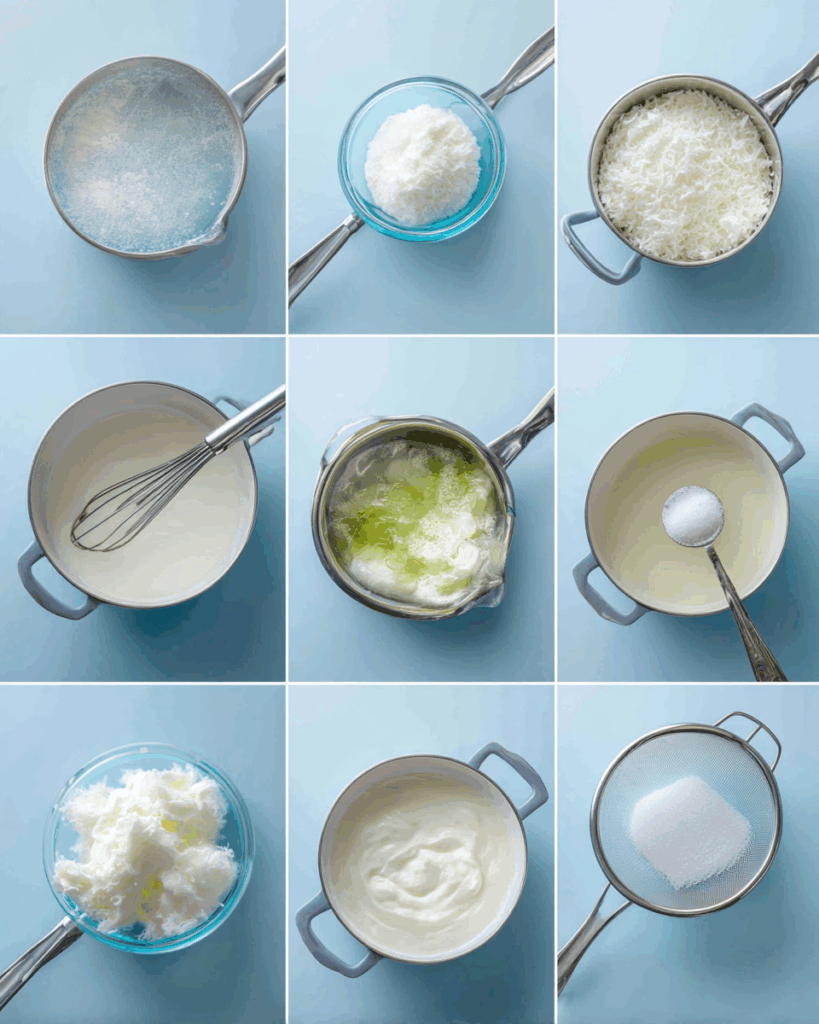
Preparing the Base: Hydrate the Gelatin
Begin by blooming the gelatin, which is crucial for achieving that smooth, jiggly texture. Take ¼ cup of your coconut water and pour it into a small bowl. Sprinkle the unflavored gelatin over the top and whisk gently until it dissolves. Let it sit for about 5–10 minutes. This step allows the gelatin to absorb moisture and become fully hydrated—ensuring it melts evenly later.
If using agar-agar instead of gelatin, follow the packet instructions and boil it with the liquids to activate the gelling process properly.
Heating the Coconut Mixture
In a small saucepan, combine the remaining ¾ cup of coconut water, 2½ cups of full-fat coconut milk, and ¼ cup of honey. Stir the mixture constantly over medium heat until it becomes hot—do not let it boil. Boiling can cause separation or a curdled texture.
Once the honey is completely dissolved and the mixture is steamy (but not bubbling), it’s time to remove it from the heat.
Incorporating the Gelatin and Vanilla
Now, add the hydrated gelatin to the hot coconut mixture. Whisk thoroughly until the gelatin is fully melted and evenly combined—this step is vital for a smooth, uniform texture. Add ½ teaspoon of vanilla extract and stir again. Vanilla not only adds a pleasant aroma but also balances the natural flavor of the coconut.
If you’re worried about any undissolved clumps, pour the entire mixture through a fine mesh sieve into a large measuring cup or bowl. This ensures your final jelly is perfectly smooth.
Pouring and Chilling
Next, divide the mixture evenly into 6 small glass jars or ramekins. Using clear containers is a great idea because it lets the layers and colors shine through—especially if you’re adding fruit later.
Let the jars sit uncovered in the refrigerator for one hour to allow the surface to firm up slightly. After one hour, gently place the lids on and continue chilling for at least 3–4 more hours or until the jelly is fully set.
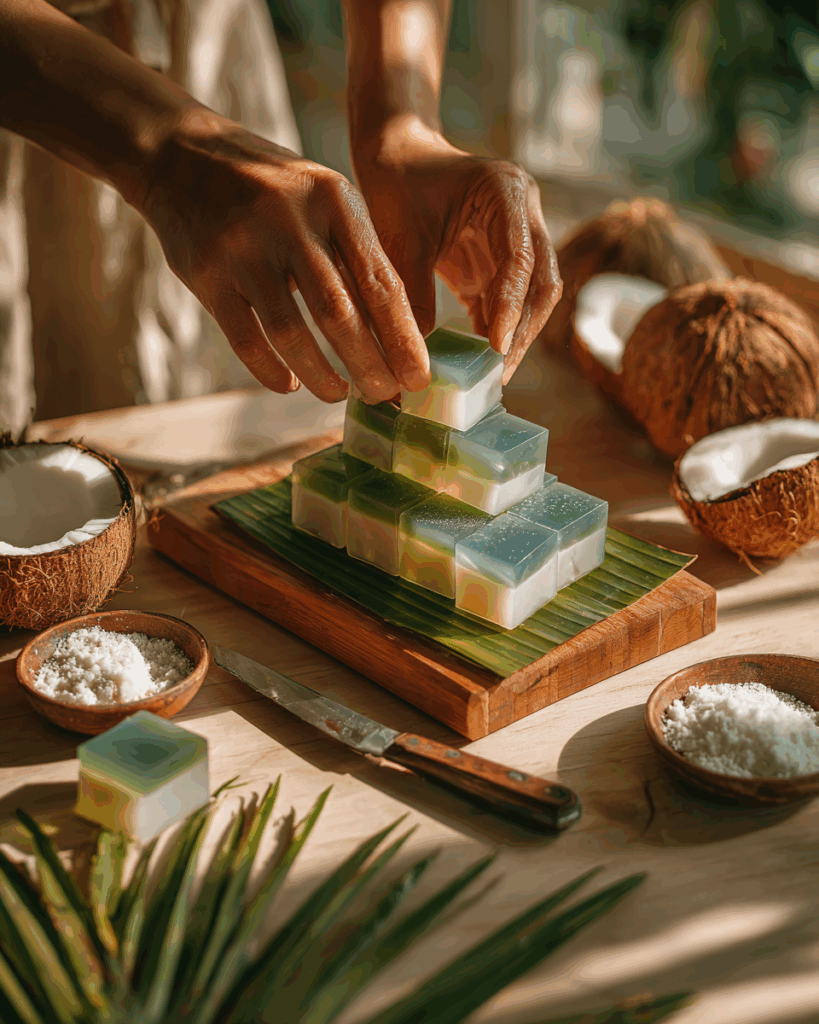
If you’re preparing this dessert ahead of time, it’s best to refrigerate overnight to let the flavors meld beautifully.
Serving Suggestions
Once the jelly is fully set, remove it from the fridge and get creative with your toppings. Add slices of fresh fruit like mango, pineapple, strawberries, or lychee. A sprig of mint or a sprinkle of toasted coconut can elevate both the flavor and presentation.
For a refreshing twist, drizzle a few drops of pandan essence on top before serving. The natural aroma pairs beautifully with coconut and adds a splash of green color.
Storage Tips
- Keep the coconut jelly refrigerated in airtight containers for up to 3 days.
- Do not freeze—freezing changes the texture and may result in watery, separated layers.
- If adding fresh fruit, do so just before serving to maintain freshness and prevent sogginess.
This preparation method guarantees you’ll end up with a light, tropical dessert that’s perfect for summer or any time you need something cool, smooth, and satisfying.
Customizing Your Thai Coconut Jelly
Add Your Personal Touch with Flavor Variations
The classic Thai Coconut Jelly Dessert is delicious on its own, but the real fun begins when you start customizing it. Whether you’re tailoring it for dietary preferences, flavor preferences, or visual appeal, there are countless ways to make it your own. The best part? You don’t need to be a pro chef to get creative.
Here are some exciting flavor variations and additions to try:
Pandan Infusion
Add 1–2 teaspoons of pandan extract to the coconut mixture before setting. Pandan brings a naturally sweet, grassy aroma and a subtle green color that pairs beautifully with coconut. This variation mirrors many Thai pandan jelly dessert recipes and gives your dessert a vibrant Southeast Asian twist.
Mango Swirl
Before pouring the mixture into jars, layer in swirls of mango puree for a fruity marbled effect. Not only does it taste amazing, but it also adds visual elegance to the jelly—ideal for entertaining.
Chocolate Coconut Jelly
Want something indulgent? Mix 2 tablespoons of unsweetened cocoa powder into a small portion of the hot coconut milk mixture, then layer it on top of the original jelly in the jars. This two-tone dessert balances creamy coconut with rich cocoa.
Layered Jelly Dessert
Divide your mixture into two portions. Add matcha to one and pandan to the other. Pour one layer at a time, allowing the first to set slightly before adding the second. You’ll get a layered Thai jelly dessert that looks just as good as it tastes.
Make It Keto, Vegan, or Paleo Friendly
Keto-Friendly Thai Coconut Jelly Dessert
To make your jelly low-carb and sugar-free:
- Replace honey with ⅓ cup liquid allulose or erythritol.
- Use unsweetened full-fat coconut milk.
- Top with keto-approved fruits like raspberries or blackberries.
The result? A Thai coconut jelly dessert with coconut milk that fits into a ketogenic lifestyle without sacrificing flavor.
Vegan Version
For a plant-based spin:
- Swap gelatin with agar-agar powder (use about 2 tsp for the same yield).
- Replace honey with maple syrup or agave nectar.
Remember, agar sets firmer and faster, so work quickly once it’s dissolved.
Paleo & Clean-Eating Options
For a paleo-approved version, stick with:
- Organic full-fat coconut milk
- Raw honey or pure maple syrup
- Fresh fruit toppings only (no processed add-ons)
This clean approach brings out the dessert’s naturally tropical flavors and is easy on the digestive system.
Fun & Colorful Toppings
Toppings not only enhance the taste but also make your dessert pop on the plate. Here are some fresh ideas:
| Topping Idea | Why It Works |
|---|---|
| Mango slices | Adds natural sweetness and bright color |
| Lychee or longan | Traditional Thai fruits that pair beautifully |
| Pomegranate seeds | Tart contrast and ruby-red visual appeal |
| Kiwi rounds | Bright green and tropical taste |
| Toasted coconut | Adds crunch and nutty depth |
| Mint leaves | Refreshing contrast and visual flair |
| Butterfly pea flowers | Adds deep blue color and herbal aroma |
Make sure to add fruit only after the jelly is set, right before serving. This keeps the textures fresh and avoids excess moisture in the jelly.
Create a Stunning Presentation
Want to wow your guests? Try these serving tips:
- Serve in stemless wine glasses or small mason jars for a modern look.
- Add a dollop of whipped coconut cream on top for extra indulgence.
- Garnish with edible flowers or lime zest for a tropical finish.
These enhancements take your Thai coconut jelly dessert recipe from simple to stunning, making it ideal for birthdays, baby showers, or dinner parties.
Nutritional Benefits of Coconut Jelly
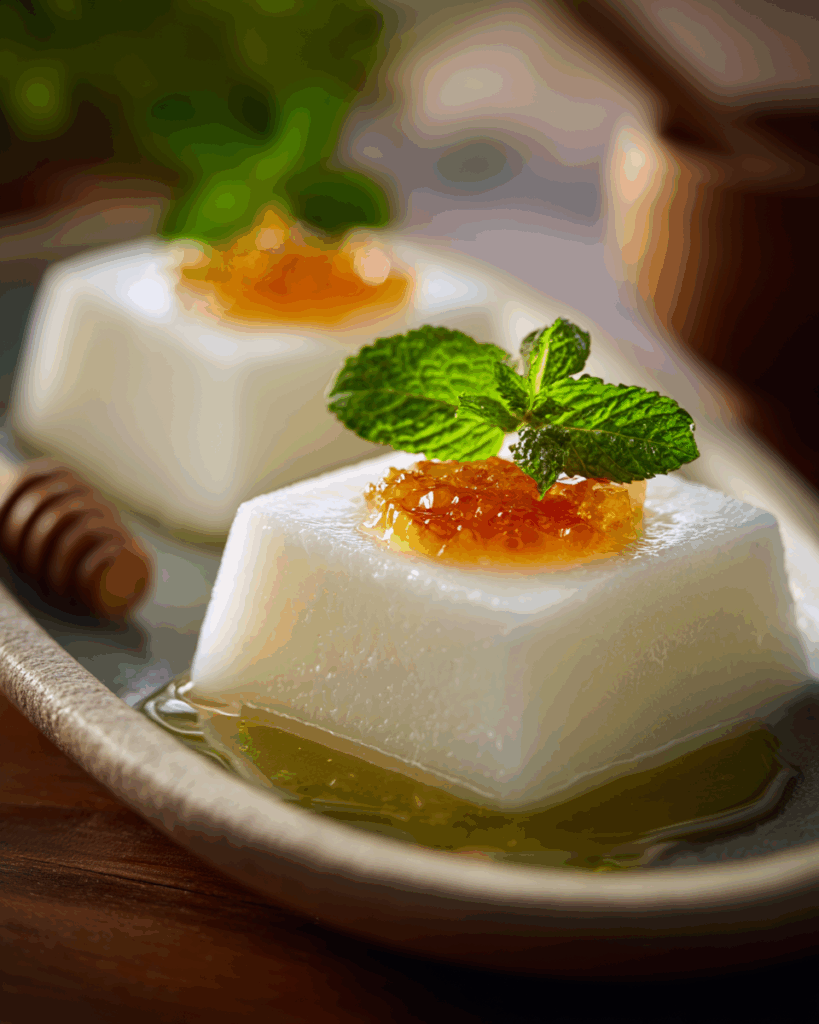
What is Coconut Jelly Good For?
Beyond its mouthwatering flavor and velvety texture, Thai Coconut Jelly Dessert offers some surprising health benefits. This tropical treat isn’t just a sweet indulgence—it can actually be a smart addition to your diet, especially when made with clean ingredients.
Let’s break down the nutritional perks you’ll enjoy with each spoonful.
Hydration Hero
Coconut water, one of the core ingredients, is naturally rich in electrolytes like potassium and magnesium. It helps maintain hydration and supports muscle function. So if you’re craving something light after a workout or during the summer heat, this dessert can actually help replenish your system.
Healthy Fats from Coconut Milk
Coconut milk delivers medium-chain triglycerides (MCTs)—a type of healthy fat that’s known to boost energy, improve brain function, and even aid in weight management. These fats are digested more easily than long-chain fats, making this dessert a smart source of slow-burning energy.
The creamy base of this Thai coconut jelly dessert with coconut milk makes it satisfying enough to curb sugar cravings without the need for heavy dairy or processed sweets.
Low-Calorie Dessert Option
If portioned properly, this jelly can be a low-calorie treat that still satisfies your sweet tooth. Each 6-ounce jar contains roughly:
- 140–160 calories (based on regular coconut milk and honey)
- Less than 10g of sugar if sweetened with allulose or erythritol
- 0g cholesterol
- Minimal sodium
Compare that with a slice of cake or a scoop of ice cream, and it’s easy to see why many health-conscious foodies are turning to Asian coconut jelly recipes as a lighter alternative.
Dietary-Friendly by Design
Here’s how Thai Coconut Jelly Dessert aligns with common dietary needs:
| Diet Type | Compatibility |
|---|---|
| Vegan | Yes, with agar-agar and maple syrup |
| Keto | Yes, with allulose and unsweetened coconut milk |
| Paleo | Yes, with raw honey and clean ingredients |
| Gluten-Free | Naturally gluten-free |
| Dairy-Free | 100%—coconut milk is the star |
This makes it an ideal choice for anyone avoiding processed foods, dairy, or refined sugars.
Easy to Digest
Because it’s made with gelatin or agar and plant-based ingredients, Thai Coconut Jelly Dessert is also gentle on the digestive system. The jelly texture requires minimal chewing and is soft enough for both kids and elderly folks to enjoy comfortably.
People with lactose intolerance or dairy allergies will appreciate that there’s no cream or milk—just the natural richness of coconut.
A Light Finish to Any Meal
Many Thai desserts are designed to refresh the palate after a spicy or savory meal. This jelly does exactly that—it cools the mouth, soothes the senses, and provides a slightly sweet finish without overwhelming your taste buds.
It’s no wonder Thai families serve Thai jelly desserts like this one after rich meals or on hot afternoons. The balance of flavor, nutrition, and presentation makes it a go-to dessert for all seasons.
Comparisons With Similar Desserts
Thai Coconut Jelly Dessert vs. Vietnamese Coconut Jelly
If you’ve ever tasted coconut jelly outside of Thailand, you might’ve had the Vietnamese coconut jelly recipe, known as thạch dừa. While both desserts share coconut-based ingredients, the differences in texture, presentation, and preparation are notable.
Thai Coconut Jelly Dessert is typically softer and silkier, with a smooth, creamy base from full-fat coconut milk and natural sweeteners like honey. It’s often served in glass jars and topped with tropical fruits like mango or lychee for an elegant presentation.
On the other hand, Vietnamese coconut jelly tends to be firmer and layered. It often uses agar-agar as the gelling agent and is served in halved young coconuts, giving it a striking natural aesthetic. The top layer might be clear coconut water jelly, while the bottom layer is creamy coconut milk.
While both are refreshing, Thai Coconut Jelly Dessert stands out for its melt-in-your-mouth consistency and fragrant vanilla or pandan undertones, making it a favorite for those who prefer smooth textures over firm gelatin blocks.
Thai Coconut Jelly Dessert vs. Japanese & Other Asian Coconut Jelly Recipes
In Japanese cuisine, coconut jelly appears as part of Asian coconut jelly recipes made with kanten (agar-agar). These jellies are typically firmer and cut into cubes or served as layered desserts. Flavors are more subtle, and sweetness is often very mild, leaning toward the minimalist approach of Japanese sweets.
In contrast, Thai Coconut Jelly Dessert offers a rich and tropical profile. Thai cuisine isn’t shy about flavor—it layers coconut milk, honey, fruit, and even pandan or mango to create a vibrant dessert that’s both comforting and exotic.
Other Asian coconut jelly recipes, like those in Malaysia and the Philippines, often use combinations of Thai jelly powder, coconut cream, and flavored syrups. However, the Thai version keeps it simple and clean, relying on the pure taste of coconut milk and water, gently set with gelatin or agar.
Thai Pandan Jelly Dessert: A Close Cousin
A close relative of the Thai coconut jelly is the Thai pandan jelly dessert. While pandan and coconut often go hand-in-hand in Southeast Asian cooking, the pandan version typically has a greener hue and a more herbal, grassy flavor. It may also incorporate mung bean starch or rice flour for extra texture.
Still, the Thai Coconut Jelly Dessert offers a more universally appealing flavor profile. Its neutral, slightly sweet base pairs easily with nearly any topping or add-in, making it endlessly adaptable.
Which One Should You Choose?
Choosing between these desserts depends on your taste and the occasion. Here’s a quick comparison chart:
| Dessert Type | Texture | Main Ingredients | Sweetness Level | Serving Style |
|---|---|---|---|---|
| Thai Coconut Jelly Dessert | Silky, soft | Coconut milk, coconut water, honey | Medium | Jar with fruit topping |
| Vietnamese Coconut Jelly | Firm, layered | Coconut water, coconut milk, agar | Light | Halved coconut shell |
| Japanese Coconut Jelly | Firm, mild | Coconut milk, kanten | Low | Cubes or layers |
| Thai Pandan Jelly Dessert | Slightly chewy | Pandan juice, coconut milk, flour | Medium | Tray or bowl |
Ultimately, if you’re craving something creamy, light, and tropical that comes together with minimal ingredients, the Thai Coconut Jelly Dessert is your go-to. It’s crowd-pleasing, versatile, and perfect for everything from family dinners to elegant gatherings.
Tips for Perfect Texture and Taste

Avoiding Common Mistakes When Making Thai Coconut Jelly Dessert
Making Thai Coconut Jelly Dessert may seem simple at first glance—but getting that flawless, silky texture takes a little precision. Whether you’re using gelatin or agar-agar, one misstep can turn your delicate dessert into something rubbery, grainy, or watery.
Here’s how to make sure your Thai Coconut Jelly Dessert turns out smooth, fragrant, and spoon-perfect every time.
Don’t Boil the Coconut Milk
The first golden rule: never boil the coconut milk. High heat can cause the milk to curdle or separate, which will leave your jelly gritty. Always heat gently over medium or medium-low heat until just steaming.
Once it’s warm enough to dissolve honey and blend with the gelatin, remove it from the heat. This simple tip preserves both flavor and texture.
Fully Bloom the Gelatin
One of the most common mistakes is under-blooming gelatin. If it’s not given enough time to hydrate in cold coconut water before being added to the hot liquid, it won’t dissolve properly. This results in a jelly that may not set evenly, or worse, contain chewy lumps.
Allow the gelatin to sit in the cold liquid for at least 5–10 minutes before whisking it into the hot coconut mixture.
Strain the Mixture Before Setting
Even if everything seems well-mixed, tiny undissolved particles of honey or gelatin can remain. That’s why it’s essential to pour the mixture through a fine mesh strainer before filling your jars.
This extra step ensures your Thai Coconut Jelly Dessert comes out crystal-smooth and free of any grainy residue.
Texture Control: Adjusting Firmness to Your Preference
Some like their jelly firm and springy. Others prefer it soft and melt-in-your-mouth. Luckily, with Thai Coconut Jelly Dessert, you can adjust the firmness easily based on the amount of gelling agent used.
| Desired Texture | Gelatin Quantity (per 2½ cups coconut milk) | Agar-Agar Equivalent |
|---|---|---|
| Silky & soft | 2½ tsp gelatin | 1½ tsp agar-agar |
| Medium-firm | 3 tsp gelatin | 2 tsp agar-agar |
| Firm & bouncy | 4 tsp gelatin | 2½ tsp agar-agar |
Just remember, agar sets more firmly than gelatin and does so at room temperature, so you’ll need to work quickly if using it.
Tips for Layering and Color Contrast
If you’re going the creative route with fruit layers or pandan swirls, keep these tricks in mind:
- Let each layer cool slightly before pouring the next one to prevent blending.
- Tilt your glass jars for diagonal layers.
- Use natural colorants like butterfly pea flower, mango puree, or matcha to create beautiful contrast without artificial dyes.
Layering makes the Thai Coconut Jelly Dessert not only taste great but also look Instagram-worthy.
Serving Secrets for Restaurant-Worthy Presentation
Want your dessert to impress your guests like it would in a high-end Thai café? Try these presentation tips:
- Garnish with fresh fruit just before serving to keep it vibrant and juicy.
- A sprig of mint adds a pop of green and a refreshing aroma.
- Use transparent glassware to highlight the jelly’s creamy texture and any color layers.
- Sprinkle toasted coconut flakes or sesame seeds for added crunch.
The finishing touches matter. A well-presented Thai Coconut Jelly Dessert becomes more than just a treat—it becomes an experience.
What to Avoid Completely
To maintain the integrity of your dessert:
- Don’t freeze it—freezing ruins the texture of gelatin-based jelly.
- Avoid over-sweetening; too much sugar masks the delicate flavor of coconut.
- Don’t skip chilling time. Rushing this step can cause a partially set, uneven result.
With these tips, you’re now fully equipped to make a professional-quality Thai Coconut Jelly Dessert at home—whether you’re serving a dinner party, prepping for the holidays, or just treating yourself.
Serving, Storing, and Sharing
How to Serve Thai Coconut Jelly Dessert Like a Pro
Presentation matters—especially when it comes to a visually stunning dish like Thai Coconut Jelly Dessert. Whether you’re preparing it for guests, a dinner party, or simply to treat yourself, here are the best ways to serve it beautifully and deliciously.
Best Serving Vessels
- Mini glass jars – Elegant and perfect for single servings
- Clear dessert cups – Showcase colorful fruit toppings and layers
- Ceramic ramekins – For a rustic, homemade touch
- Stemless wine glasses – Ideal for an elevated dessert course
The creamy-white jelly pairs wonderfully with vibrant fruits like mango, kiwi, and pomegranate seeds. The contrast in colors not only adds a visual wow factor but also elevates the tropical feel of the Thai Coconut Jelly Dessert.
When to Serve
This dessert fits a variety of occasions:
- After a spicy Thai dinner
- For brunch or baby showers
- As a light snack on warm afternoons
- During holidays, summer picnics, or potlucks
Its refreshing, non-heavy texture makes it a hit year-round. Especially in summer, the coolness of chilled coconut jelly brings welcome relief.
Smart Storing Tips to Keep It Fresh
One of the great things about Thai Coconut Jelly Dessert is how easy it is to store for later enjoyment. Here’s how to do it right.
In the Refrigerator
- Storage Time: Up to 3 days
- Container: Airtight jars or containers with lids
- Do Not Add Toppings Until Serving: Fruit may release water and affect the jelly’s texture
Chilling also improves flavor as the coconut and vanilla settle together. The texture firms slightly over time, giving you that perfect spoonful every time.
Can You Freeze Thai Coconut Jelly Dessert?
No. Freezing is not recommended.
The coconut milk and gelatin structure do not hold up in freezing temperatures, resulting in a mushy or separated texture after thawing. Stick to refrigerating only.
Sharing the Joy of Thai Coconut Jelly Dessert
This dessert is easy to scale, making it perfect for sharing. You can double or triple the batch and divide it into multiple jars for gatherings. It also makes a thoughtful homemade gift—just tie a ribbon around the jar, and it’s ready to go!
Tips for Gifting:
- Print out a mini recipe card with serving tips
- Pair it with tropical tea or a Thai cookbook
- Decorate the lid with fabric or twine for a personal touch
If you’re preparing a Thai-themed dinner, why stop at dessert? Pair your jelly with something savory like a Thai chicken dish, or a flavorful soup to round out your menu.
Final Thoughts
Thai Coconut Jelly Dessert is more than just a sweet dish—it’s a celebration of balance, flavor, culture, and simplicity. Whether you enjoy it as a light finish to a meal, a guilt-free snack, or a crowd-pleasing party treat, this jelly has everything:
- It’s easy to make
- Beautifully customizable
- Rich in healthy fats and hydrating ingredients
- Naturally gluten-free, dairy-free, and adaptable for all diets
From its roots in traditional Thai kitchens to its growing popularity around the world, Thai Coconut Jelly Dessert continues to win hearts for good reason. Now that you’ve got the complete recipe, tips, variations, and serving ideas, it’s time to try it yourself.
Stay tuned for more easy, authentic Thai dessert recipes. And if you’re feeling adventurous, don’t miss our Thai Coconut Custard or Red Rubies Dessert for your next sweet experiment.
FAQs About Thai Coconut Jelly Dessert
What is Coconut Jelly good for?
Here’s where Thai Coconut Jelly Dessert really shines. It’s not only tasty—it’s also surprisingly healthy. Here’s why it’s good for you:
Hydration
Thanks to the coconut water content, this jelly offers a dose of electrolytes, including potassium and magnesium—perfect for keeping you refreshed in hot weather.
Healthy Fats
Full-fat coconut milk is a source of medium-chain triglycerides (MCTs), which promote brain function and metabolism. These fats are easier to digest and offer long-lasting energy.
Dairy-Free and Gluten-Free
The recipe contains no dairy or gluten, making Thai Coconut Jelly Dessert ideal for those with food sensitivities.
Low in Calories
A single serving is light and satisfying, especially when made with allulose or other low-glycemic sweeteners.
Gut-Friendly Texture
The jelly texture is soft and easy on the stomach. It’s suitable for kids, seniors, and anyone recovering from digestive issues.
All in all, Thai Coconut Jelly Dessert offers a rare combination: it’s indulgent, naturally sweet, and actually supports a healthy lifestyle.
What is Melo Melo made of?
Melo Melo is a modern, trendy version of coconut jelly that’s gained popularity in the U.S.—especially through dessert shops that specialize in Asian-inspired sweets. While it’s not exactly traditional Thai, it’s inspired by the same core idea.
Melo Melo typically includes:
Coconut cream or milk
Gelatin or agar for texture
Sweeteners like sugar or agave
Flavor add-ins like vanilla or fruit puree
In essence, Melo Melo is a commercial spin-off of what traditional Thai Coconut Jelly Dessert has been for generations: a simple, elegant, and satisfying tropical treat.
What sets Thai coconut jelly apart is its connection to cultural tradition, natural ingredients, and balance of lightness and flavor.
What is Coconut Jelly called?
Globally, coconut jelly goes by many names. In the context of Thai cuisine, it’s most commonly referred to as Thai Coconut Jelly Dessert, or again, “Wun Maprao.” But in other countries, coconut jelly appears under different names:
In Vietnam, it’s called thạch dừa—usually firmer, often layered, and served in young coconut shells.
In the Philippines, you might see buko jelly, a dessert with shredded coconut meat.
In Japan, versions using agar are known as kanten coconut jelly.
Despite regional differences, the Thai version stands out for its creamy, smooth texture and the balanced combination of coconut milk and coconut water.
If you’re searching for a light, naturally sweet, dairy-free treat, Thai Coconut Jelly Dessert delivers every time.
What is the name of the Thai Coconut Jelly?
The official name for Thai Coconut Jelly Dessert in Thai is “Wun Maprao”.
Wun means jelly.
Maprao means coconut.
It’s a fitting name for a dish that’s both straightforward and beloved. This name is widely recognized throughout Thailand, especially in dessert stalls, family kitchens, and local markets where Thai jelly desserts are a staple offering.
Whether served in clear glass jars or cute dessert cups, this jelly is instantly recognizable by its smooth white texture and creamy coconut aroma.

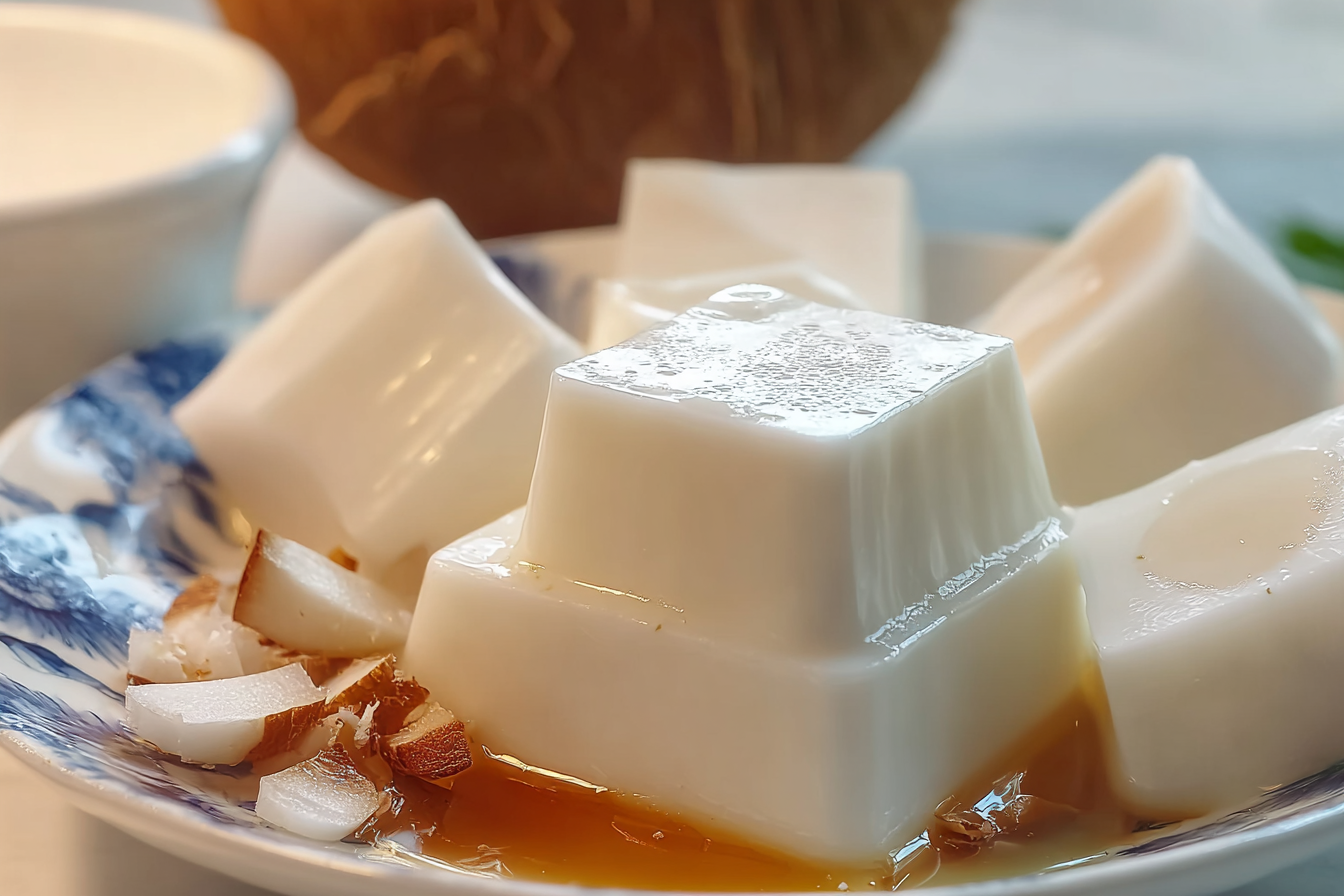
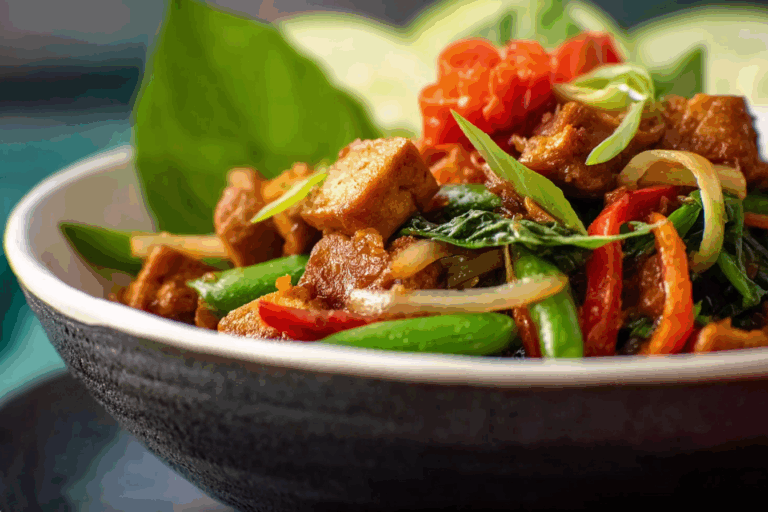
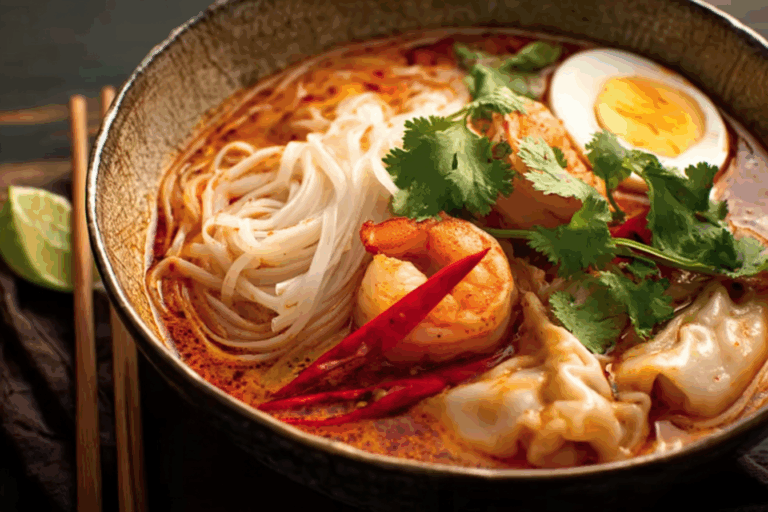
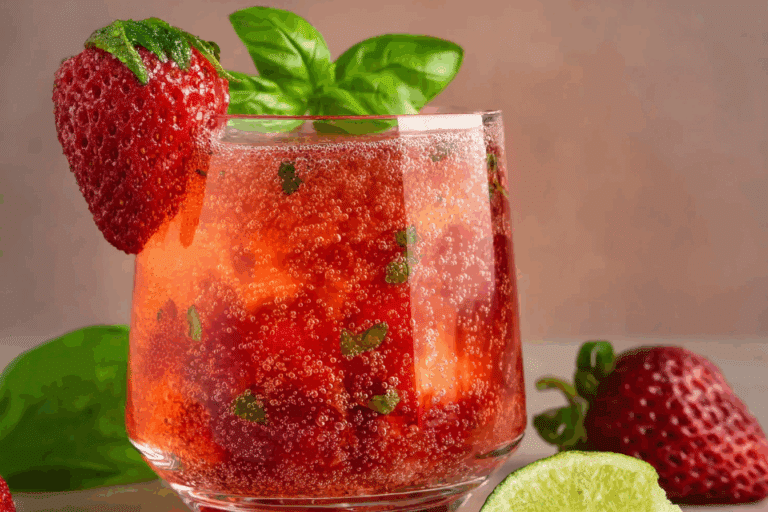
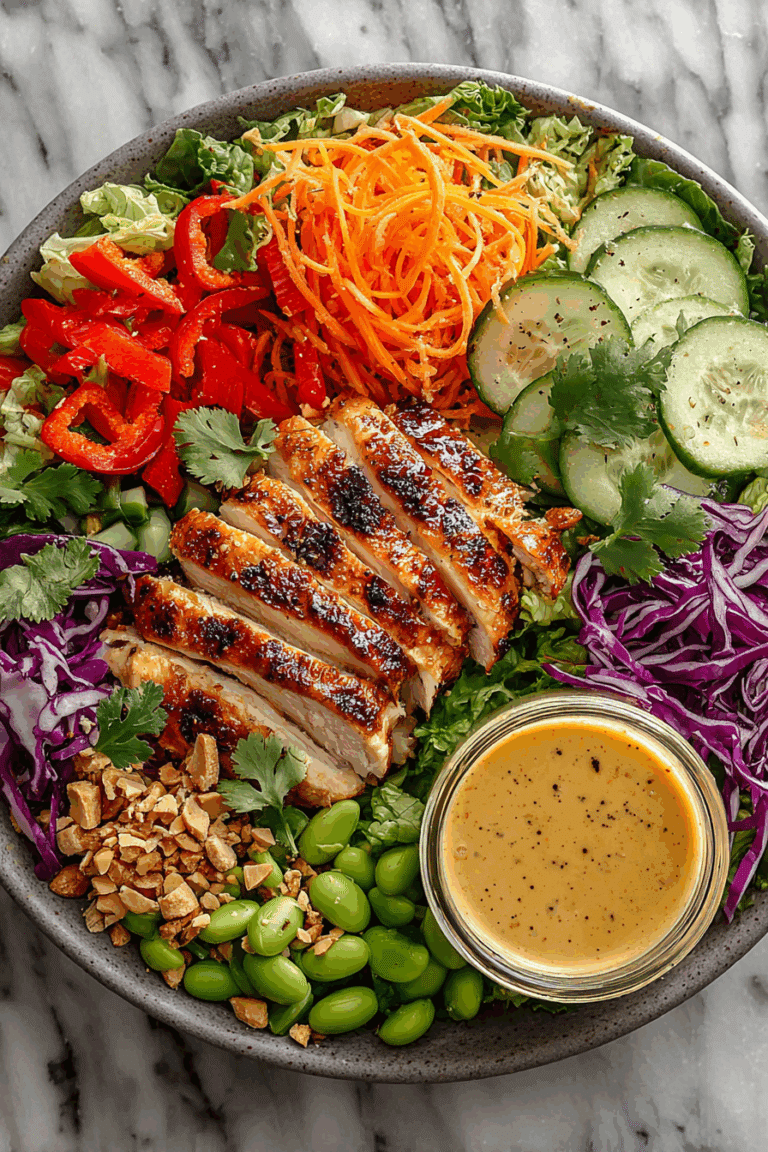
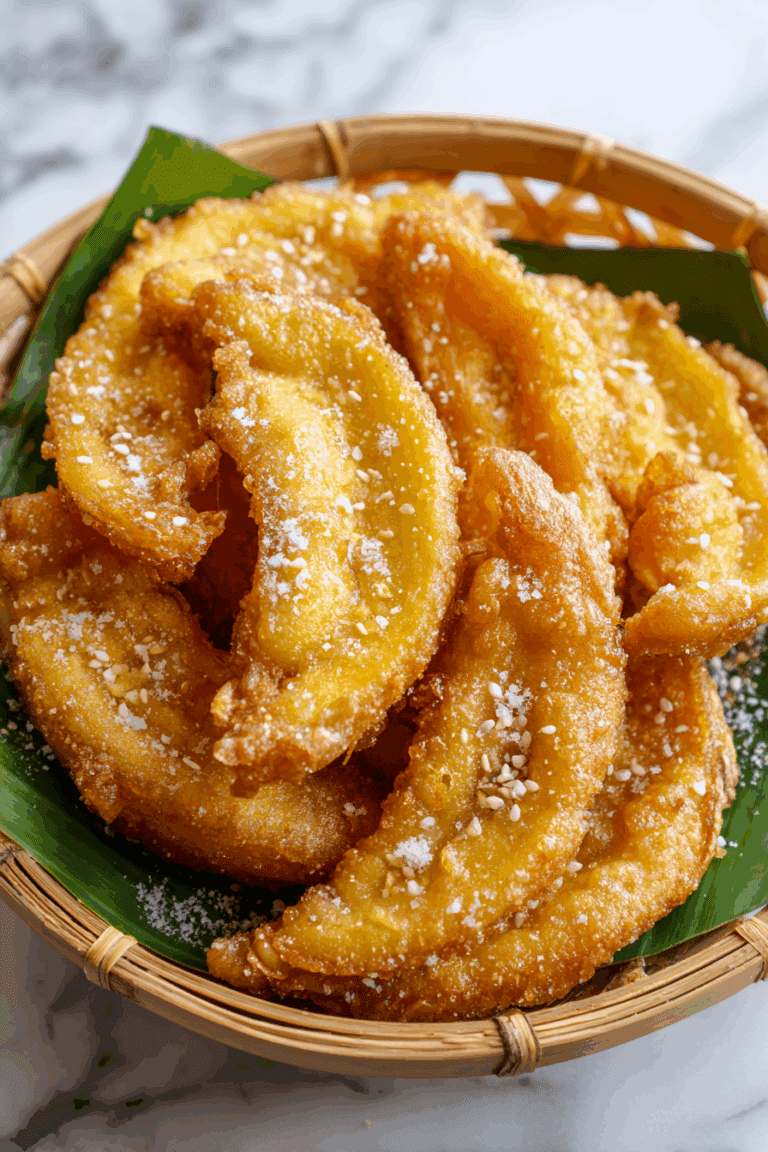
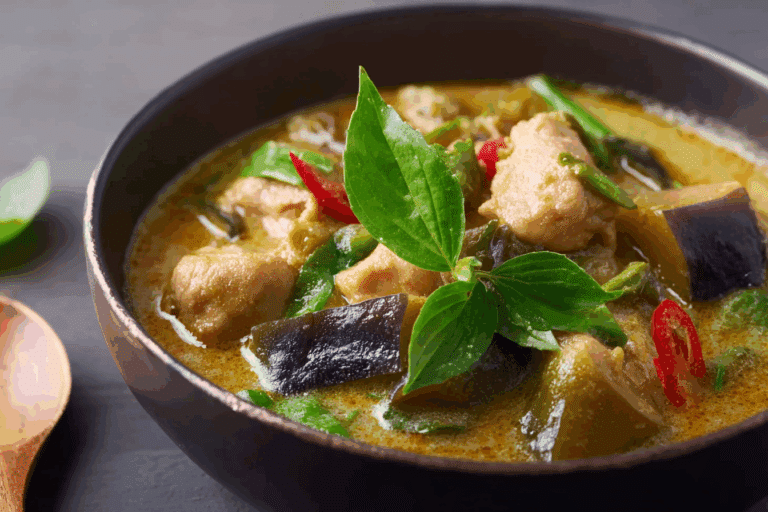
Thank you for sharing superb informations. Your web site is so cool. I am impressed by the details that you have on this blog. It reveals how nicely you understand this subject. Bookmarked this website page, will come back for extra articles. You, my friend, ROCK! I found just the information I already searched all over the place and simply couldn’t come across. What a great website.